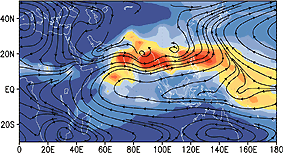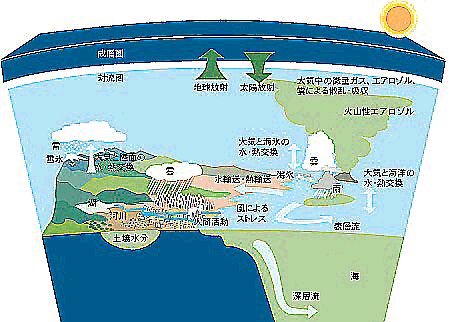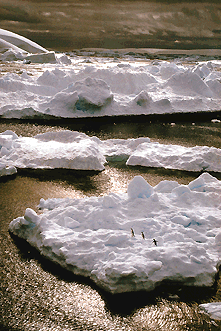

Figure 2 : Distribution of summer Asian monsoon. Precipitation(Color) and air flow(Arrow) are presented. Upper figure is obserbation, and Lower figure is simulated by AGCM.
[an error occurred while processing this directive]
[an error occurred while processing this directive]
The climate of our environment is formed through complicated interactions among the atmosphere, oceans, and land surfaces. The "climate system" collectively refers to these subsystems, which determine the Earth's surface climate. "Climate" usually refers to surface environmental states, such as temperature and precipitation, averaged over several decades. However, the climate system undergoes a wide spectrum of fluctuations, from year-to-year variability of weather to glacial-interglacial oscillations over tens of millions of years. Our Center's mission is to unveil how the climate system works and to explore the mechanisms of climate formation and its variability.

Figure 1 : Conceptual figure of Climate System:
Miscellaneous processes and their interaction affect to the climate
We study the climate system as one that obeys the laws of physics.
Unfortunately, the usual experimental approach cannot be applied to
the real Earth. Therefore, we have adopted an alternative approach:
constructing another Earth on the computer. This "climate model" is
built to simulate the real climate system as faithfully as possible;
not only winds and currents, but also rain, snow, ice, and clouds are
programmed in the model to work in a physically consistent manner. The
model is under continuous testing and validation against observed
data. Of course, nature is beyond human understanding, and the model
does have flaws. However, through numerical experimentation using
various types of models, our understanding of the complex workings of
nature is constantly advancing. We are making continuous efforts to
improve the model and to gain a better understanding of the natural
system.
Figure 2 : Distribution of summer Asian monsoon.
Precipitation(Color) and air flow(Arrow) are presented.
Upper figure is obserbation, and Lower figure is simulated by AGCM.


 Water wanders within the climate system in various forms. It is
transported by winds as water vapor, forms clouds, and sometimes falls
on land or sea surfaces as precipitation. Fluctuations in global water
circulation can easily change the distribution of floods and droughts.
Therefore, investigation of water is the key to understanding the
climate system.
Water wanders within the climate system in various forms. It is
transported by winds as water vapor, forms clouds, and sometimes falls
on land or sea surfaces as precipitation. Fluctuations in global water
circulation can easily change the distribution of floods and droughts.
Therefore, investigation of water is the key to understanding the
climate system.
Photo: The JR Oito Line was cut off by the flood of the Himegawa River after the Shinetsu Heavy Rainfall in July 1995. (Courtesy of Mai-nichi Shinbun Co.)

Snow and ice reflect solar radiation effectively and keep the surface
temperature low. Once the climate gets warmer and the snow/ice extent
is reduced, the warming is accelerated. Sea ice also controls the
salinity distributions in oceans. Therefore, the sea ice model is one
of the crucial ingredients in the climate system model.
Photograph : presented by Olion Press
